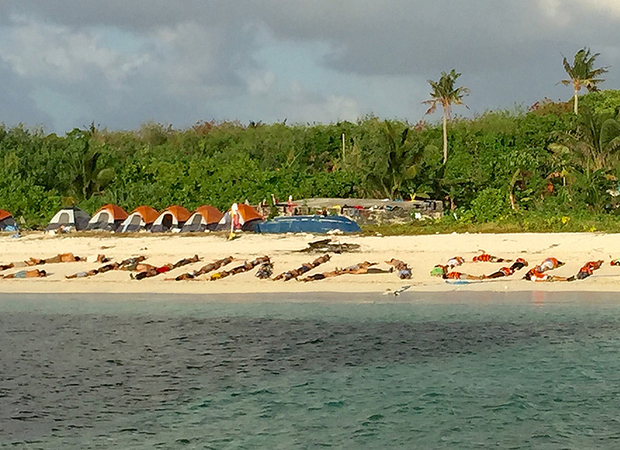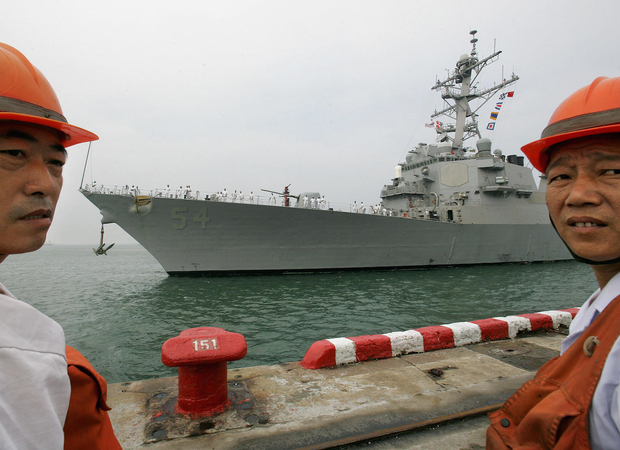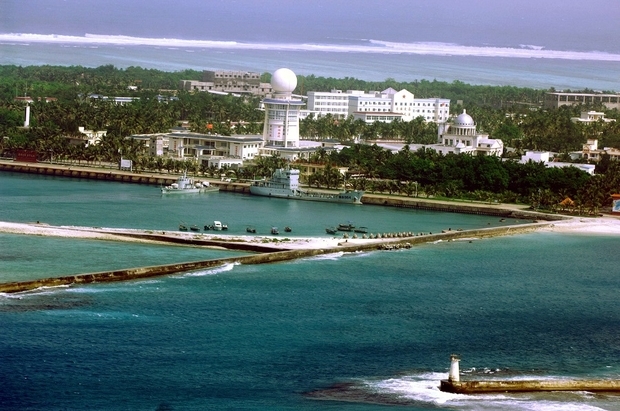Soldiers, ships, and military outposts are the usual tools of nations staking out their territory. But on disputed shoals in the South China Sea, Beijing may be deploying a new arsenal: soccer fields, pipelines, and tea shops.
Woody Island is a tropical oasis about three-quarters of a square mile, just over half the size of Manhattan’s Central Park, with a runway jutting into the sea. It’s the largest of the Paracel group of islands in the South China Sea. Formerly inhabited during parts of the year by transient Chinese fishermen, the tiny island now has a population upward of 1,000, including military personnel and permanent residents who make their living by fishing in what China calls Sansha City, the name of the island settlement. In 2012, one Chinese fisherman told state news agency Xinhua that when he first moved to the tiny island in 1979, people lived in wood huts. Now, according to Chinese state media reports, residents sip coffee and read books at cafés under the palm trees when the sun is shining and at night they gather at a beer plaza to enjoy ice-cold drinks. When they’re not fishing or swimming in the sea, they jog around a track, play sports on a grass field, or challenge each other to badminton matches at a brand-new recreation area.
While beer plazas and badminton courts sound unremarkable, ensuring that the islands are habitable could potentially strengthen China’s assertion of sovereignty over the island chain and the rest of the South China Sea. China claims about 90 percent of the South China Sea, a body of water spanning more than 1.3 million square miles through which $5.3 trillion in trade pass every year and which may hold significant oil and gas deposits. Taiwan and Vietnam also claim the Paracels; China has controlled the archipelago since winning a battle with Vietnam in 1974. The Spratlys, another major archipelago in the South China Sea, are even more hotly contested, with about 45 islands, reefs, and other maritime features occupied by military from China, Taiwan, Vietnam, the Philippines, and Malaysia. The countries have built an assortment of facilities on the islands, but in the past two years, China has reclaimed land from the sea to build airstrips at a frenetic pace, far outstripping facilities built by other countries and straining regional ties. The latest uproar over Beijing’s claim focused on its deployment of surface-to-air missiles and the construction of radar facilities on Woody Island, first reported in February.
But military facilities are far from the only infrastructure China has added. Over the past few years, with little international scrutiny, China has built up non-military features to make Woody Island more hospitable. According to Chinese state media reports, a school opened on December 2015 to provide education for about 40 children of island residents. Comforts of home are readily available on the island’s main thoroughfare, Beijing Road. As in mainland cities, residents can use an ATM, eat at restaurants and tea houses, send letters from a post office, receive medical treatment at a hospital, and shop for clothes and electronics at several small department stores. Sansha even has its own state broadcaster, Sansha TV. There is little need to sail to the Chinese province of Hainan over 250 miles away. Woody Island is a key hub for China in its claims to the surrounding sea. It serves as the administrative center for all the island groups and surrounding waters China claims in the South China Sea, including the Spratlys. Sansha is directly administered by the central government; Chinese officials stated after Sansha’s upgrade to a prefecture-level city in 2012 that the move “announces to the rest of the world that China has indisputable sovereignty over this region.” According to an August 2014 Xinhua report, the upgrade was intended to “help manage about [2] million square [kilometers] of islands, coastal areas and territorial waters in the South China Sea.”
Viewpoint
01.08.16
The Storm Beneath the Calm: China’s Regional Relations in 2016
China is also inviting private investment to build further infrastructure on the islands, of which Fiery Cross Reef in the Spratlys appears to be the second most developed. Future projects could include a regular flight service, the building of docks, and a maritime rescue center, according to a January 15 Xinhua news agency report. Sansha Deputy Mayor Feng Wenhai said that submarine optical cables and comprehensive Wi-Fi coverage also lay in the island’s near future.
Experts say better living conditions for the residents could strengthen China’s case for legal recognition for its extensive territorial claims. “If they can’t sustain ‘human habitation,’ then the islands are not entitled to generate 200 nautical mile exclusive economic zones under the terms of the U.N. Convention on the Law of the Sea (UNCLOS),” said Bill Hayton, author of the book South China Sea: The Struggle for Power in Asia and associate fellow at the Royal Institute for International Affairs in London.
Li Dun, a professor of politics as Tsinghua University in Beijing, did not see as direct a relationship between construction of civilian infrastructure on the islands and broader strategy. “To see a country’s foreign policy, you don’t judge it from one single gesture or one case,” Li told Foreign Policy in an interview. “You look into the general structure of a country’s foreign policy.”
Installing water treatment facilities on the islands has been a particular priority. On Woody Island, workers are hurrying to lay water pipelines and complete a water treatment system that would turn seawater into drinkable water with a freshwater capacity of 1,000 tons, according to a December 2015 report from Sansha TV. “Not having fresh water would undermine part of the purpose of all the civilian infrastructure—which is to demonstrate that the island does sustain human habitation for that exclusive economic zone claim,” Hayton told Foreign Policy. Fiery Cross Reef, with a population of 200 military personnel, already boasts a seawater treatment plant and rainwater collection system. Meters are installed in showers to restrict residents to a maximum of 110 pounds of water for bathing per week.
China’s aggressive defense of its claims has stoked tensions across the region. Under the slogan of “big country diplomacy,” Chinese President Xi Jinping has asserted territorial claims more boldly than his recent predecessors, resulting in an increase in maritime confrontations. In October 2015, the United States responded by sending a U.S. Navy destroyer through the Spratlys to conduct a freedom of navigation operation (FONOP). Admiral Harry Harris, head of the U.S. Navy’s Pacific Command, said on February 23 that China was “changing the operational landscape” in the South China Sea and that the United States would increase FONOP patrols. Beijing has long reproached America’s involvement, accusing the U.S. of raising regional tensions with its patrols and surveillance. Foreign Ministry spokeswoman Hua Chunying argued on February 23 that “China’s deploying necessary, limited defensive facilities on its own territory is not substantively different from the United States defending Hawaii.”
Conversation
02.02.16
How Close Was the Latest Close Call in the South China Sea?
The Permanent Court of Arbitration in The Hague, which assists in international dispute resolution, is expected to issue a decision by May on whether it agrees with the Philippines’ assertion that Chinese sovereignty over almost all of the waterway is out of line with the entitlements for coastal states under international law, and that China’s occupation and use of natural resources is illegal. If the court rules in favor of Manila, an “optimistic scenario” may be that China will bring its claims into line with UNCLOS for recognition of exclusive economic zones, according to Hayton. If Beijing were to claim exclusive economic zones for individual islands instead of the wide swath of territory under the U-shaped nine-dash line, that could imply that the overall scope of China’s claims would be reduced.
But Beijing so far has made no indication it would take the tribunal’s ruling into account. In 2015, the Chinese Foreign Ministry called a preliminary ruling from the tribunal “null and void” and said future judgments would have no effect in China. “There is a very strong possibility that Beijing will just ignore the arbitration result,” Li Mingjiang, a professor at Nanyang Technical University in Singapore, wrote in December 2015. “Many [Chinese foreign policy elites] firmly believe that Washington has been heavily involved from the beginning, and that Manila initiated the case to provoke and put political pressure on Beijing.” Others argue that China couldn’t completely ignore a tribunal decision in favor of Manila since it would face heavy international pressure to comply. (The Chinese Ministry of Foreign Affairs did not respond to multiple emailed requests for comment.)
Even if international acceptance of China’s claims seems unlikely, the building up of non-military features serve other purposes, said Yanmei Xie, senior China analyst for International Crisis Group. “Beijing wants to demonstrate its effective control and use of them to boost the government’s legitimacy at home and to deter rival claimants from attempts to weaken Chinese control,” Xie told Foreign Policy.
“China’s actions to assert its sovereignty in the South China Sea are greeted with cheers among the Chinese public,” said Xie. “Highlighting civilian facilities—as opposed to the more controversial defense-related installations—is a lower-cost way for the Chinese government to demonstrate sovereignty, consolidate control, and score domestic support.”
Popular support for China’s presence on the islands has appeared to only increase with reports of more military stationed there. The new infrastructure has made for great domestic public relations, with Chinese media publishing popular slideshows on the islands’ quirky features, including tomato patches and flower beds. Some Chinese have taken to micro-blogging platform Weibo to discuss why this is a great time to pack their bags and move to Woody Island. “With all those soldiers who can protect you and the beautiful scenery, it seems completely ideal there,” one user wrote. Others imagined starting a simple life growing vegetables on the island, while one user asked: “With the mainland’s economic downturn, how is the island still short of people? Count me in!” Such nationalist support also makes it less likely that China can easily reduce or retract its claims without appearing weak to its own citizenry.
As island infrastructure improves, China is also encouraging more citizens to visit as tourists. Chinese cruise ship Coconut Princess has brought Chinese tourists to the South China Sea since 2013 to “swim among the reefs and sandy shoals,” and Chinese authorities are eyeing a second cruise ship route to the Paracels. In January, Fiery Cross Reef residents welcomed the arrival of two civilian airliners, serving as successful test flights and signaling further development.
While the legality of China’s claims remains unclear internationally, the new infrastructure has certainly improved the lives of island residents. “Since Sansha was established as a city, conditions have gotten better and better,” Sansha resident Huang Zhiying told a reporter on January 1. “We don’t have to worry about eating and drinking, we don’t have to worry about electricity, we don’t have to worry about mobile phone reception.” Huang, who had been designated one of Sansha’s 10 Model Residents for 2015, had come to the island more than a decade before with her husband and son. The island is now their home. “As residents, our work and lives are extremely convenient, no different from other cities.”




